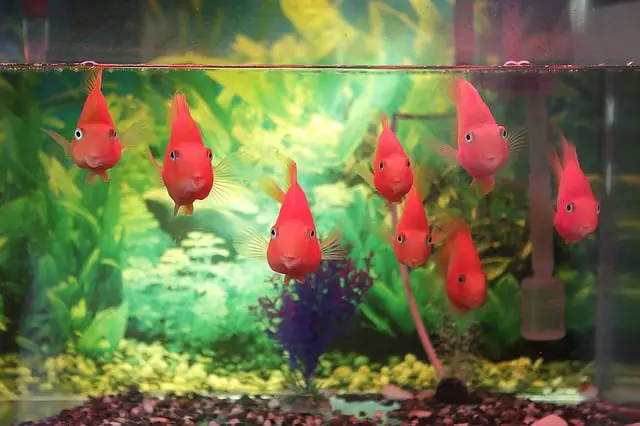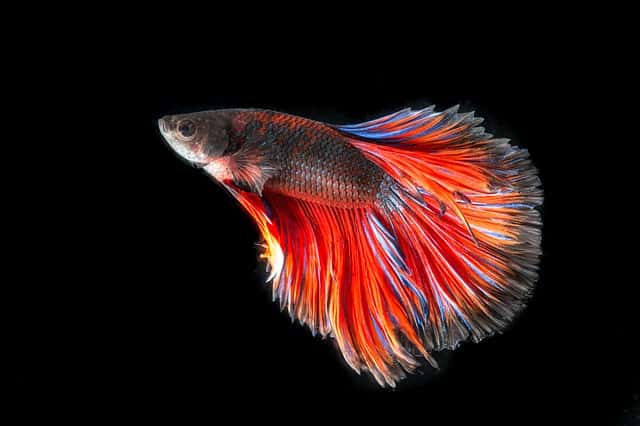If you are new to the aquarium hobby or maybe stick to either freshwater or saltwater tanks, you might not be familiar with one of these types of skimmers. Personally, I was very familiar with protein skimmers, as I have had marine tanks for years but didn’t know much about surface skimmers. Now that I am getting into tropical freshwater tanks and love planted tanks, I am quickly learning what surface skimmers are and why I now need one.
What is the difference between a surface skimmer and a protein skimmer? A surface skimmer is used primarily in a freshwater tank for cleaning the water surface area. A protein skimmer is used primarily in a marine tank cleaning out fine proteins and organic compounds.
Now that you know the difference between a surface skimmer and a protein skimmer, let’s take a closer look at this in more detail below. We’ll discuss how a skimmer works and how to fix oily water in a tank. So, if you’re ready to learn more, then let’s get started!
How Does a Surface Skimmer Work?
A surface skimmer is usually hooked up to the inlet hose of a canister filter. There are models that can be hooked up to some hang on back filters however, the more common ones are connected to canister filters.
When set up, the surface skimmer can be adjusted for the flow sucked in through the top to skim the surface and from the bottom of the skimmer which sits underwater below the top end of the piece. The water taken from the top of the skimmer (the surface end) sucks out all of the oily, filmy ‘crap’ from the top of the water through the filter to run through the filter media. Thus, being taken out of the tank.
Surface skimmers are very simple pieces of equipment which is why they are not overly expensive. Just make sure you pick one that you know will work with your setup.
Here is a clean looking surface skimmer on Amazon. There are many different kinds to choose from. This particular one wouldn’t stand out like a sore thumb in your tank.
What Does a Surface Skimmer Clean out of Tank? (What causes an oily film)?
If you have a planted tank, the chances of a film developing on the top of the tanks water increases. Live plants debris are notorious for causing this. Other reasons you might be experiencing an oily film on the top of your tank include:
- If you are using a food not meant for fish, it might be the cause. Which, by the way, if you need ideas on human foods, you can feed fish check out my article on that topic here. Regardless, if you are buying fish food make sure it is of high quality.
- Algae and bacteria could be the culprit. The best way to avoid this is providing regular maintenance to the tank like water changes, cleaning filtration and making sure excess food and poop are being taken out as soon as possible.
- Before you ever stick your hands in the water, make sure they are free of moisture and soaps, as this will cause an oily film, especially in smaller tanks. Larger tanks might not be as noticeable however, even in a bigger tank, make sure your hands do not have anything on them that can be transferred to the water .
How to Temporarily Fix Oily Water in a Fish Tank
If you haven’t purchased a surface skimmer yet, there are a few alternative ways to clear the waters surface in the meantime until you get the proper equipment.
- I haven’t used this one myself but read in a forum recently where someone was using extra strength paper towels and would just lay them on the water briefly then lift them out in the hopes they absorbed some of the organic compounds thus removing them.
- This one I have used. If you have a bubbler, turn it on at full strength. It doesn’t take out the organic compounds, but it does clear the surface allowing a better exchange of gases and letting more light into the water.
- Another idea I read in a forum which I think is a brilliant idea. Take a plastic bottle cutting it in half. Slowly lower either half into the water with the open end facing upwards. Lower it so the surface water starts to fill the bottle. The trick is to do this, so you get mostly surface water.
How Does a Protein Skimmer Work?
Protein skimmers are used in marine tanks to clean out organic compounds and waste by-products. I can tell you at a basic level what happens without adding in any big scientific words.
But first, let me ask you this, have you ever seen the foamy bubbles on the shores of the ocean or even a lake? Have you noticed that there is a lot of dark crud in those bubbles? That is nature cleaning out the ocean and lakes. What you are looking at are organic compounds being cleaned out of the water. We need devices though to accomplish this process.
Essentially what happens is your protein skimmer creates bubbles at the bottom of the skimmer and as the bubbles rise, they come into contact with organic compounds, which stick onto the bubbles for a ride up to a collection cup or area. The bubbles will then pop leaving the proteins and other organic compounds in the collection cup to be disposed of. It’s that simple!
You will find different companies making skimmers that look different than other skimmers, just know that they all try to accomplish the same thing.
I like this hang on back style protein skimmer over on Amazon. Reason being is when they are hang on the back, they don’t take up room in the tank and they are easy to access. You don’t have to worry about how it will fit within your canopy and lighting.
What Does a Protein Skimmer Clean out of a Fish Tank? (What are the Benefits)?
Protein skimmers remove organic waste before the waste breaks down and releases nitrogen into the water, which means nitrate levels rise and can be a real problem for a marine tank, especially if you have corals. Corals do not do well with nitrate levels that are elevated. Even though nitrates are not as bad for fish as ammonia or nitrite, if there are higher levels, it can kill your fish.
Using a protein skimmer also means you won’t have to do as many water changes, as water changes clean out the same compounds that a skimmer cleans out of a fish tank. You just don’t get the benefit of vacuuming fish poop off the tanks base with a skimmer. So, you’re not totally off the hook with your water changes.
It doesn’t matter which model you buy, they all try to accomplish the same objective. To get organic compounds to ride bubbles up to the collection area.
I have had internal and hang on back protein skimmer models and found both worked quite well. The only issue you might have is adjusting the bubbles so there aren’t too many being produced. If you crank the skimmer right up and have too many bubbles, you’re going to lose a lot of water without waste products. There is a bit of an adjusting period so take your time and make sure you have the skimmer set just the way it needs to be.
Regardless of whether you are using a protein skimmer or a surface skimmer it is very important to do water changes. Check out my article on the subject to learn more.
Conclusion
It’s important to take away the following information from this article.
Surface skimmers are for freshwater/tropical aquariums. They remove organic compounds that form an oily looking film on the top of the aquarium water. Live planted tanks are more likely to have this happen than fish only tanks however, depending on what’s causing the issue, you could still have this happen with a fish only aquarium.
Protein Skimmers are for marine aquariums. They also remove organic compounds out of the water. Protein skimmers are almost essential to own, if you plan on having a marine tank for a long time. If you want corals, then a protein skimmer is a must-have.
Good luck!
Related Aquariums-at-Home Articles.
Should Aquarium Filters Always be On?
Do Saltwater Tanks Need a Protein Skimmer?






